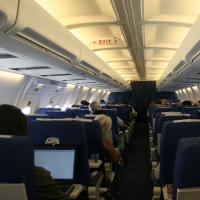Staying Connected in the Air Gets Easier—But Is That a Good Thing?

A few years back, a traveler could only work with offline or downloaded material while in transit. That situation has changed now, at least largely in the US, where many domestic flights have in-flight Wi-Fi.
Gogo continues to be the leading brand in this space. By signing deals with several more flight carriers and with its IPO last year, Gogo further positions itself for a niche leadership position. Gogo recently has taken flight communication options to the next level by announcing that passengers would soon be able to make in-flight calls and send text messages using its mobile application for iOS and Android.
While domestic flights continue to make fast strides in staying connected in the air, international travel has not caught up because the implementation is a little more complex with higher altitude flying, flying across oceans, and extended durations of in-flight time. One of the concerns is loss of battery life while in transit necessitating in-flight power points. This might even call for some aircraft redesign in order to support the required number of power points.
Despite the growth in the US flight sector, the potential for further growth is still huge on the domestic front. Reports show that only 38 percent of flights offer in-flight Wi-Fi at this time and that sessions are still expensive—almost $12 each. While the cost element is important to keep in mind when examining usage, usage patterns show that there's a long way to go before take rates reach higher numbers.
Is it just the cost that keeps people away from connecting in the air, which is a mere 6.2 percent as of Q1 2013? There is possibly a stronger non-technology element that is supressing usage—an element of wanting to rest while in-flight and not wanting to disturb nearby passengers. Will this hit the take rates further once in-flight calling becomes possible?
I was recently watching a wall post from a technology-savvy Facebook friend, who started a thread about the possibility of using Skype in-flight. Several other people who were equally tech-savvy said they would be hesitant to use such applications—even if they become possible down the line—for the sake of maintaining a silent ambience in-flight.
Imagine, a flight deck with hundreds of people busy texting, making Skype calls, making phone calls, and powering up their devices. Is such chaos warranted at the risk of losing out on some much needed rest—especially when you are crossing oceans and timezones in international flights running more than ten hours per leg?
While the technology advancements are great to see, it is time to put on our thinking caps and possibly draw the line on how much of staying connected is really needed.

